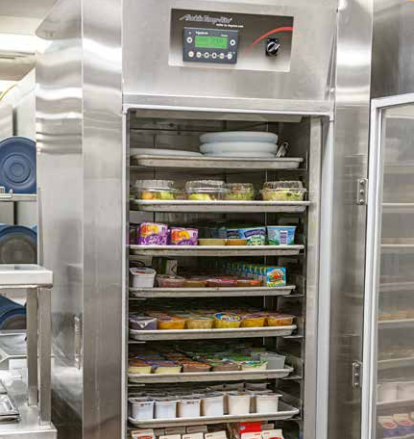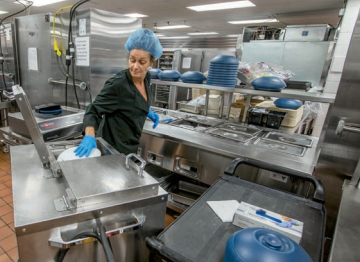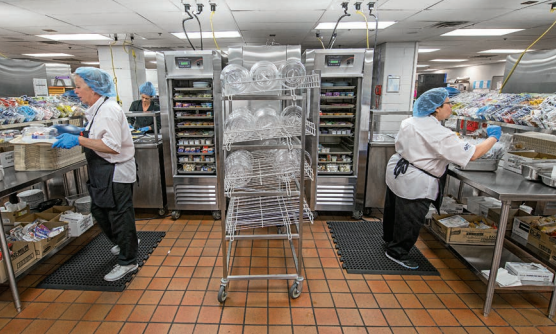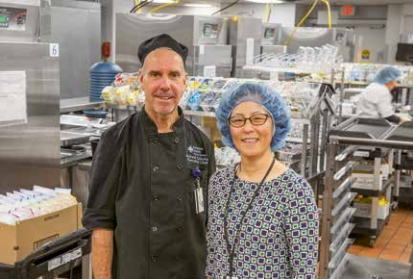Spoken Menu Nourishes Patient Satisfaction at Baystate Medical Center
Baystate Medical Center’s patient satisfaction scores improved with the launch of a Spoken Menu concept combined with guest service ambassadors and a new pod tray assembly area supported by Aladdin Temp-Rite’s Heat on Demand Advantage and Ready-Chill systems.
Baystate Health is a consortium of four hospitals and medical centers located in western Massachusetts. The not-for-profit healthcare provider’s mission is “to improve the health of the people in our communities every day with quality and compassion.” Baystate Medical Center, a 714-bed acute care hospital in Springfield, is the only level 1 trauma center in this part of the state.
From 2007 to 2013 Baystate Health’s Food and Nutrition department provided room service to its patients. This delivery method offered patients an extensive menu and multiple service hours. Despite the convenience offered to patients, it wasn’t working well. “We weren’t getting meals to the patients in an appropriate amount of time, which is 45 minutes to one hour,” says Nancy Robinson, BS, MBA, Director for Patient and Guest Services. “We couldn’t meet the timeframe consistently during peak volume times in part because of inefficiencies in the kitchen, and the amount of distance between the kitchen and the new tower’s patient rooms.”
Robinson and Richard Callahan, Baystate Medical Center’s Chef and Production Manager, asked a consultant to examine the operation and suggest operational efficiencies. An evaluation team recommended a hybrid model, minimizing room service and adopting a spoken menu/ambassador/pod tray assembly system. “We pushed back,” Robinson admits. “A second consultant also recommended the same approach. We decided to take their advice, and reached out to Premier, Inc., a group purchasing organization, and Aladdin Temp-Rite, for their expertise and support.”
Several goals were set:
- To increase patient satisfaction with food and nutrition;
- To offer patients two high-quality choices instead of multiple room service menu choices that were often inconsistent in quality;
- To make getting a meal a simpler, more personal interaction;
- To ensure patients receive their hot food hot, and cold food cold, by streamlining the assembly and delivery to under 45 minutes to one hour;
- To offer alternative menu items such as pizza, sandwiches, hamburgers and salads to patients who want other options;
- To simplify and reduce menu offerings and liability of exposure to so many products offered by room service.


A pod air curtain refrigerator allows staff efficiencies. For example, doors remain open efficiently produces during tray assembly.
To determine if the return on investment of capital and time would be valuable for Baystate, Aladdin Temp-Rite Territory Manager Peter Savenko took Callahan and Young Hee Kim, MS, RD, LDN, CNSC, to other healthcare establishments that had achieved similar goals using the spoken menu/ambassador/pod system in combination with Aladdin Temp-Rite’s Heat on Demand Advantage® and Ready-Chill® systems.
Callahan and Kim were impressed with what they saw, and decided to proceed with the change at Baystate Medical Center. Two months before going live, Callahan took two supervisors, a chef and the trainer back to those same hospitals so they could also see the system in operation and get their feedback to give management and co-workers. “That was the key in making this successful,” Callahan says. “Once the supervisors and staff saw it function, it made sense to them and they were able to translate how it would work to other staff.”
Efficient, Effective Patient Tray Service
Today, on patient floors, a staff member, called a guest service ambassador, speaks with patients. They verbally present the menus, place orders and deliver meals to patients. “If patients have a food-related problem, they tell nurses or the ambassadors, who solve the issue,” Callahan says. “This helps nurses in so many ways. Now there’s a point person for food-related issues. These issues are much fewer than they were in the past. Tray accuracy is close to or at 100 percent now. The nurses can then focus on other points of care for the patients they are responsible for.”


Pod workstations are designed to balance workloads. Donna
Seymour assembles hot food items on china plates for patient meals.
Implementing Change
The new system required a new way of thinking in the kitchen. Instead of producing food to order, cooks now produce a much smaller menu with only one or two universal items at breakfast, lunch and dinner. To successfully support the change, Baystate asked Aladdin Temp-Rite for help in creating a solution. It was determined that pod assembly workstations would be the most efficient way to accomplish the change in Baystate’s tray assembly and delivery process.
Designers at Aladdin Temp-Rite then worked with Baystate’s own in-house engineering team and provided CAD diagrams for the most efficient layout of two identical tray assembly pods. The new pod workstations enable multiple staff members to assemble patient trays simultaneously. Everything the staff members need for tray assembly is within arm’s reach, which greatly increases efficiency and speed.
“We involved the cooks early on, and asked for their feedback,” Callahan says. “They asked us to create a makeshift pod so they would better understand how it would work before using it for actual production. They accepted the challenges, and added flair to it, as well.”


| Baystate Medical Center’s Old Main entrance welcomes patients and visitors. |


Staff members Susan Dziedzic (left), Marilyn Baez (right) and Donna Seymour (back) assemble custom trays in identical pod workstations. Everything needed for assembly is within easy reach.
TIMELINE
2007 (March) – Baystate implements facility-wide room service with a Mediterranean-flair menu. The system features a call center, with all food cooked to order and delivered via Heat on Demand. Despite the change, patient satisfaction scores remain relatively flat.
2012 – Health system expands the main hospital building by adding a new tower dedicated as the Mass Mutual tower. This features beautiful, state-of-the-art patient rooms. However, meal delivery and service time to the new tower exceed 45 minutes to one hour.
2013 – Patient satisfaction scores decrease due to longer delivery times after a meal is ordered. Delivered hot and cold food temperatures are unsatisfactory. The Food and Nutrition management team reaches out to Premier, Inc. and Aladdin Temp-Rite in April to provide options for Baystate to consider, to reverse declining patient satisfaction.
2013-2014 (September to April) – Conversion to hybrid service model including a Spoken Menu with guest ambassadors combined with room service for maternity, pediatric and oncology floors. Staff efficiency was improved by assembling nearly 80 percent of patient trays in the new pod tray assembly workstations. Special request menu items are provided as needed. Patient satisfaction scores increase, along with the staff’s satisfaction in the new system. Tray accuracy rises to nearly 100 percent.
THE TRANSITION PROCESS
In September 2013, once the decision was made to proceed with the new spoken menu/ambassador/pod tray delivery system, Robinson, Callahan and Kim initiated a pilot program to define the parameters of the program and work out any issues. Implementing the new system required extensive training. “We created an ambassador training program for a person who was responsible for training two to three ambassadors for three weeks, or until they were proficient in order taking, menu and diet knowledge and customer service,” Callahan says. They also had to learn how to input patient menu selections into an iPad that’s integrated with the hospital’s foodservice software system.
A unit was converted every three weeks. “We went live with as many units as we had available on December 18, 2013, and we were fully converted in late April of 2014,” Robinson says. “Peter Savenko and Eric Roebuck, both with Aladdin Temp-Rite, were on-site the day before we went live to help us put equipment together, set it in place and make sure it was functional. They were both here for the first meal produced. This is a tremendous example of how they provided excellent customer service beyond our expectations.”
During the transition process to the new system, two other meal delivery systems were still in place. Room service with a full-choice menu was available to patients who were not on ambassador floors, and a pre-select meal was available to other patients.
“We created a makeshift pod in the kitchen,” Callahan says. “As we added a unit, we increased pars in one area and decreased pars in another. It was somewhat difficult, but attainable. As more units were converted, we could anticipate menu variances and have them readily available".
“The arrival of the pod equipment was timed with the removal of the old equipment,” Callahan says. The outsourced electrical installation was completed after equipment installation.
As units with ambassadors increased, demand on the room-service line decreased. “It took a while, created some confusion and frustration, but everyone worked together as we adjusted times and communicated with each other,” Robinson says.
ROBINSON AND CALLAHAN’S HARD-LEARNED LESSONS AND ADVICE
- If possible, go live with all applicable units at once. The initial shock will be difficult, but it will even out quickly and make life less hectic in the long run.
- Don’t start at Christmas or any other major holiday. While census may be lower, many staff take time off, which adds an additional level of difficulty for conversions.
- Do a site visit so you can see in person how another hospital handles challenges similar to those you face. Watch how the equipment works while actual food production and tray assembly are taking place.
- Communicate, communicate, communicate! It’s critical so that all your staff, including nursing, senior administration and everyone else impacted will know what’s going on. Nurses are a valuable ally for foodservice, and should be engaged in the process from the beginning. Because most trays are delivered to the floors at the same time, and there will now be a point-person for food-related issues, nurses will appreciate how this change will provide more freedom for them to focus on better patient care.
FACTS OF NOTE
Type of Facility: Acute-care hospital; only level 1 trauma center in western Massachusetts
Beds: 714 licensed beds
Average Patient Meals/Day: 1,800
Hours of Service: 6:00 a.m. to 7:00 p.m. After 7:00 p.m., patients receive food held in storage in the units. Late trays are delivered room-service style.
Menu Specialties: Breakfast menus include dishes such as scrambled eggs, omelets, French toast and pancakes. For lunch and dinner, sandwiches such as the chicken portobello Philly sandwich are popular, along with hot entrées such as chicken Parmesan with whole wheat pasta and house marinara; roast pork with plantains and black beans; salmon salad with creamy yogurt dressing; pot roast jardinière; Greek chicken with Mediterranean couscous; and cranberry chicken salad.
Staff: 110 FTEs
Total Project Cost: $300,000
Equipment Investment: $245,000
Website: www.baystatehealth.org
KEY PLAYERS
Owners: Baystate Health, Springfield, Mass.
Director for Patient and Guest Services: Nancy Robinson, BS, MBA
Executive Chef and Production Manager: Richard Callahan
Clinical Nutrition Manager and Supervisor of the Ambassador Program: Young Hee Kim, MS, RD, LDN, CNSC
Food and Nutrition Supervisors: Ron Thibodeau; Rita Martinez; Sara DiPinto; Bruce Cierpial; and Chris Einhaus
Group Purchasing Organization: Premier, Inc.
Aladdin Temp-Rite Representatives: Peter Savenko and Eric Roebuck
Baystate’s guest service ambassadors enter patient meal orders into an iPad that’s integrated into the hospital’s foodservice software system. Meal orders are held in queue until a designated time, then batch-printed as tickets into the kitchen. The supervisor on duty separates the tickets by unit, and in predetermined sequential order gives the featured menu item tickets to the pods and any outlier items to the room service line for that particular unit. Those meals are prepared, then coordinated at the pod, and the entire floor’s trays are delivered at once. This process continues unit by unit until all meals have been prepared, assembled and delivered. Today, nearly 80 percent of all patient trays are produced and delivered as part of the new pod system and 20 percent of the units use either room service or preselect menu service due to the nature of the patients’ conditions and foodservice needs.
Each pod contains Aladdin Temp-Rite equipment, including two air-curtain refrigerators, a five-well steam table and a stainless steel worktable. The pods feature Aladdin Temp-Rite’s Heat on Demand Advantage and Ready-Chill systems. Advantage is an induction heat activator that has a 12-second heating cycle for pellet bases. The system maintains hot food temperatures at or above 140 degrees F for up to one hour, without having to use a heated plate. If a heated plate is used, the Advantage system will keep food hot for up to 73 minutes. Baystate also uses Advantage on their room service line.
The Ready-Chill system, which holds cold food for up to an hour, includes freezable cold bases, domes and dishes. Aladdin Temp-Rite meal transport carts used by Baystate hold 16 trays, and feature a built-in top rail, pass-through doors and four swivel casters.

Richard Callahan, Executive Chef, and Young Hee Kim, Manager, Clinical Nutrition, inspect tray assembly and maintain high-quality standards throughout the operation.
“Once one unit’s trays are done, we start tray fulfillment for another unit,” Robinson says. “We are now able to produce 500 to 600 meals in one and a half hours three times a day. The hot food delivered to patients is hot, and the cold food is cold, the perfect combination.”
Overall patient satisfaction scores have increased significantly, and the hospital’s staff is extremely pleased. “We monitor satisfaction using PRC (Professional Research Consultants) scores regarding patient scores of percentage excellence,” says Robinson. “Our ranking among our peers went from low teens with a room service model to 70 percent with our new hybrid model. What could be a better outcome?”
